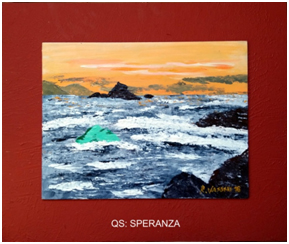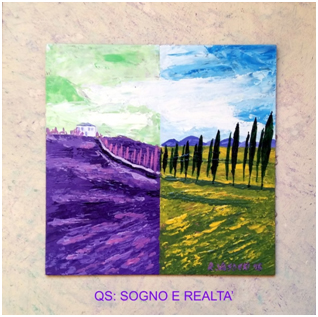- di Maria Teresa Prestigiacomo -
Roma: Il manifesto dei quadri situazionali di Riccardo Vasdeki è affidato a noi per la diffusione alla Stampa, in esclusiva. Formuliamo al maestro alcune domande, per meglio chiarire i termini del manifesto che inaugura una corrente nuova, unica, quindi.
D: Maestro Vasdeki, quali sono i maestri che hanno ispirato la sua pittura?
R: Dai miei dipinti si capisce che tutti gli impressionisti sono nel mio background pittorico, soprattutto Claude Monet e Vincent Van Gogh, a cui devo aggiungere William Turner maestro di luci e di atmosfere.
D: Da dove trae nutrimento l’ispirazione per la sua pittura?
R: Nasce dalla vista di ciò che tocca la mia sensibilità. Le opere che mi riescono meglio sono quelle che alla prima vista del soggetto mi hanno provocato un "tuffo al cuore" che, per fortuna, avviene ancora in persone mature come me.
La natura ci fornisce ogni giorno spettacoli meravigliosi e sempre nuovi per composizione e per colorazioni. Ignorarli mi sembra uno spreco e quasi un insulto al Signore che ce li porge gratis. I miei dipinti mostrano che io sono attratto dal bello, e non dipingerò mai un quadro verista come una scarpa vecchia o un cestino dell'immondizia;
D: Qual è il processo di definizione ed elaborazione dei suoi quadri?
R: Quando avverto il “tuffo al cuore” inizia il processo mentale che mi porterà a dipingere un nuovo quadro; inizio a pensare sia al “taglio” del soggetto, cioè quale parte del soggetto trasferirò sulla tavola, sia anche a quanto aggiungerò di personale all’immagine, anche se questa scelta avverrà definitivamente ma istintivamente “in corso d’opera”. Questa è la mia pittura “sensoriale”, come è stata molto esattamente definita dal critico d’arte Maria Teresa Prestigiacomo.
E la decisione del “taglio” dell’inquadratura, quella della dimensione della tavola, quella delle tonalità base…tutto questo mi impegna anche per giorni o settimane fino al momento in cui sento di essere pronto ad iniziare. Allora nasce in me una sorta di frenesia realizzativa che mi fa cominciare a dipingere e che vorrebbe non essere interrotta fino al termine; sono estremamente concentrato ed appartato dal mondo esterno e proseguo con continuità cercando di finire presto. E’un momento che impegna tutta la mente nello sforzo pittorico ed è inevitabilmente stancante anche fisicamente, come tutte le attività di grande concentrazione.
I quadri che reputo meglio riusciti (opinione condivisa dai miei osservatori) sono quelli iniziati e finiti nella stessa mattina o pomeriggio.
D: Trova la spatola strumento da adottare ancora per la sua produzione pittorica?
R: Da quando ho appreso dal maestro Mario Salvo la tecnica della spatola stratigrafica è rimasta una costante; un leit motiv strumentale; dopo averci preso la mano diventa molto facile e accattivante usarla. Ciò che apprezzo di più è l'essenzialità del tratto, il piacere di riuscire con una sola “strisciata stratigrafica” ad esprimere una situazione anche complessa e da ciò consegue la velocità di esecuzione: i tempi di realizzazione sono ridotti drasticamente e questo è un vantaggio nella riuscita del dipinto. Dal momento in cui inizio a pensare a come realizzare l'immagine io entro in una sorta di trance artistica ed è importante e produttivo rimanervi dentro per tutta la durata della stesura; se devo interrompere la pittura lo stato di trance termina e non riprenderà uguale nel momento della ripresa, anzi può non riprendere affatto. In casi del genere il dipinto finale risente dell'interruzione e può anche dare l’impressione di essere stato realizzato da 2 pittori differenti.

D: Ci esponga i connotati del “situazionismo”, sua nuova modalità espressiva, da lei inaugurata ( costituirà oggetto di studio e di analisi della storia dell’arte contemporanea come nuova corrente)
R: I miei quadri raffigurano principalmente paesaggi e spettacoli naturali (albe, tramonti, mareggiate, etc.) ed hanno una propria valenza come memoria di un evento realmente avvenuto. Ma essi contengono intrinsecamente un messaggio rivolto a tutti, spesso non percepito dall’osservatore.
La presa di coscienza di questa situazione mi ha spinto ad evidenziare il messaggio intrinseco nel paesaggio attraverso colorazioni diverse da quelle originali e con un titolo esplicativo da cui l’espressione “situazionismo”.
I miei “Quadri Situazionali (QS)” sono caratterizzati da una rappresentazione sempre figurativa che non sconfina nell’astrattismo, e per ciò stesso è immediatamente comprensibile da tutti.
D: Cosa pensa dell’uso di Internet nella pittura?
R: Internet è una realtà pregnante ed imprescindibile che nel mondo di oggi non si può e non si deve ignorare. Pensiamo ai tempi non lontani in cui ogni informazione era scambiata su supporto cartaceo ed inviata per posta: si era ancora all’era della pietra! Oggi, per fortuna, tutto avviene in modo semplice e veloce: guai a non approfittarne.
I vantaggi di diffusione di immagini e di testi in tempo reale vanno aldilà di qualsiasi altra considerazione. Io uso internet in tutti vantaggi che offre: ho realizzato il blog “quadridiriccardo.it” dove chiunque può vedere le fotografie dei miei quadri e può scrivermi per chiedere informazioni e prezzi.
Le nuove generazioni, ma non solo loro, scambiano pareri, consigli e quant’altro su internet e anche fanno acquisti in maniera semplice e veloce; non vedo come una televendita diminuisca il valore di un’opera o di un’artista
INTERVIEW TO RICCARDO VASDEKI
QUESTION. Master Vasdeki, which are your inspiring painters?
ANSWER: my paintings clearly show that all impressionist painters are in my painting background, mainly Claude Monet e Vincent Van Gogh, and finally William Turner master of lights and atmosphere.
 Q: Where does your inspiration to paint come from?
Q: Where does your inspiration to paint come from?
A: It comes from the view of everythimg touching my sensibility. My best paintings are the ones which provoked in me a “heart sang”, being something still rising in mature people. Nature supplies us every day with wonderful shows, always new in composition and colors. I feel it should be a waste to ignore them, almost an insult to God who gives them to us free. My paintings show that only beauty attracts me; I will never paint an old shoe or a garbage basket.
Q:: In which way do you define and handle your paintings?
A: When I feel the “Heart sang” then I start working mentally to the aim of defining the paint; I start thinking either to the subject cut, ie the subject to paint on the wood, or to my contribution to the imagine, even if this choice will happen during painting. This is my “sensorial painting”, as correctly defined by the art critic Maria Teresa Prestigiacomo.
Thinking to the subject cut, to the wood dimensions, to the basic colors… all this keeps my mind engaged for days or weeks until the moment when I feel ready to start. At that time a kind of realizing frenzy arises in me which forces me to paint without interruptions until the end. During this phase I am very concentrated on my activity, I feel apart from the word around me, and I keep on painting trying to ending as soon as possible. In these moments all my mind is concentrated in the painting effort which is physically tiring, as all high concentration activities.
My best paintings are the ones started and ended in the same morning or afternoon.
 Q: Do you still use spatule while painting?
Q: Do you still use spatule while painting?
A: From the time when Master Mario Salvo teached me the stratigrafic spatule technique, I always use it; after the first learning times it becomes very easy and attractive to use it.
What I more appreciate is the essentiality of the stretch, the pleasure of succeed, with only one stratigrafic swiping, in expressing an even complex situation, which shortens the realization times, being a big advantage in the painting. If I have to stop painting, the trance status stops as well, and it will never start again at the restart, being even possible that it will not start at all. In such case the final paint could be interpreted as realized by two different painters.
Q: please tell us something about “Situazionismo”, your new way of expressing.
A: My paintings’ subjects are more often landscapes and natural shows (sunrises, sunsets, sea storms etc.) and their valence is overall the memory of a really happened event.
The conscience of this situation pushed me to point out the message intrinsic to the landscape through colors different from the original ones and by giving to the painting a special title explaining the pointed situation; from this the expression “Situazionismo”.
My “Situational paintings” are therefore characterized by a figurative representation, not trespassing to “abstractism”, keeping well comprehensible from everybody.
Q: What do you think of the use of internet in painting?
A: Internet is a pregnant and essential reality of today, and it shall not and have not to be ignored. Let’s think to not far times when every information was exchanged on a paper support and sent through the post offices: it was the stone era! Today, fortunately, everything happens in a simple and quick way; woe not to use it!
The advantages of diffusing images and texts in real time are beyond whichever every other consideration. I use internet in all its advantages; I made the blog “quadridiriccardo.it” were everybody can watch my paintings’ fotos and can write me to ask information and prices. New generations, but not only, exchange opinions, advises and everything else via internet; they also buy everything quickly and simply. I can’t see how a TVsale could decrease the value of a work or of an artist.